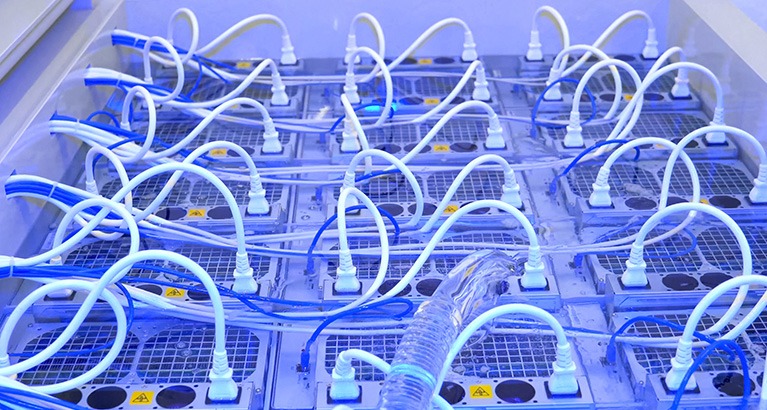Is it possible for Great Britain to completely decarbonise its domestic heating sector? David Reiner, Professor of Technology Policy at Cambridge Judge Business School, believes that while the task is challenging it is not as daunting as some have claimed – and thermal energy storage techniques could play a big role.
Despite Britain being a global leader in reducing emissions, there has been relatively little progress made in the heating sector which alongside power, transport and business dominates UK emissions. The government has committed to the net-zero carbon emissions target by 2050, so decarbonising the heating sector is becoming an urgent task.
“Decarbonising heat is often perceived as a daunting task since natural gas serves between 60 and 80% of the domestic heat sector in countries like UK, the Netherlands and United States with high consumer satisfaction,” says a recent study co-authored by David. “Domestic heat accounts for 14% of UK emissions in 2021, only fell by 17% over 1990-2020. So to reach zero, emissions reduction will need to increase 6 times as quickly as they have historically.”
Decarbonising heat is often perceived as a daunting task since natural gas serves between 60 and 80% of the domestic heat sector in countries like UK, the Netherlands and United States with high consumer satisfaction.
Why sceptical consumers can make full electrification challenging
The authors conclude that full electrification of the UK domestic heating sector will be challenging, in large part due to slow uptake by some “domestic consumers, who will be sceptical of the technology and/or daunted by the capital expense” of newer techniques such as heat pumps.
And as for the British government: “Current UK government policy to incentivise heat pumps badly lags behind other European countries and the government’s own targets. As evidence that such deployment is possible with more effective incentives, many European countries (Italy, France, Poland, etc) have recently seen a dramatic increase in installations,” the authors say.
Current UK government policy to incentivise heat pumps badly lags behind other European countries and the government’s own target.
Thermal energy storage has a key role in meeting domestic heat demand
Research by David and colleagues at the Energy Policy Research Group at Cambridge Judge breaks new ground by examining hourly historical gas demand data, finding that UK domestic peak heat demand is nearly 50% lower than widely cited levels. Taking advantage of non-coincident peak demand across Britain, “[a] 100% electrification pathway can be achieved with only a 1.3-fold increase in generation capacity” by leveraging thermal energy storage (TES) that allow heating and cooling to be stored and used later to meet varying demand.
Without TES, additional capacity would need to increase by 40%, which underlines the technology’s utility as a seasonal balancing tool for electric heat.
“While there is no silver bullet to decarbonise heat, we have shown in the present study that electrification of heat in conjunction with smart operation of TES constitute a viable candidate without needing unreasonably rapid growth in overall system capacity although deploying TES at scale is challenging,” the study concludes.
Consumers and government need to take action to meet decarbonisation goals
“The basic takeaway from our research is that while electrification of domestic heating is vital for the UK to reach its decarbonisation goals, actions by both consumers and government lag badly behind what needs to be done”, says David. “While clearly challenging, our study shows that electrification of heating is not as daunting as some have claimed – in part due to the promise of thermal energy storage in meeting the current time-oriented mismatch between demand and supply”.
“But while electrification is vital to achieve net-zero goals, there are other really important elements of what we refer to as the ‘heat puzzle’, which extends beyond homes to commercial and industrial heat demands – and this includes the potential role for heat networks, biomass and hydrogen – so the Energy Policy Research Group based at Cambridge Judge Business School is also undertaking research into these areas.”
But while electrification is vital to achieve net-zero goals, there are other really important elements of what we refer to as the ‘heat puzzle’, which extends beyond homes to commercial and industrial heat demands.
What does Britain’s domestic heating sector look like?
Roughly 85% of UK households are connected to the gas grid and the remainder are off grid. The majority of off-grid properties use electricity, solid fuels and oil burners for heating. Very few (less than 3%) employ technologies such as district heat networks, ground-source heat pumps, air-source heat pumps and micro combined heat and power systems.
Domestic heating demand varies in different regions of the UK, with higher demand in the southeast and Scotland. The authors also note that there are various levels of incumbency across the regions, with regions in the north of England having the lowest share of more traditional electric heating technologies while south of England has the largest share and 26% of homes in Scotland are not connected to the gas grid at all.
The Government’s target for the heat pump rollout is for 600,000 units annually by 2028 and yet in 2023, only 35,000 heat pumps were installed in the UK, which indicates the dramatic scale up that would be needed including in the workforce of heat pump installers.
How do you work out the impact of British heat electrification?
The study’s authors modelled region-specific heat demand profiles for 13 local distribution zones (LDZ) of the country’s gas network. There were 2 goals of the study:
- examine implications of electrifying domestic heat
- identify barriers and enablers in the pathways for heat decarbonisation
Working out the impact of British heat electrification is difficult as it depends on varying heat demand across different regions. The authors note that the lack of heating demand data on an hourly basis is one of the key challenges.
To tackle this, they collected hourly gas consumption data from all of the gas distribution networks who provided data from exit points of the 11 local distribution zones in Britain over a number of years and examined “time series to develop hourly and region-specific domestic head demand data.” A new model was developed, as well as 4 different scenarios to analyse the impact of different system assumptions on electrification. And to assess the incremental effect of heat electrification a ‘NoHeat’ scenario is proposed “where the power sector is fully decarbonised by mid-century but not heat.”
The paper – entitled “The impact of 100% electrification of domestic heat in Great Britain” – is co-authored by Vassilis M. Charitopoulos of University College London, Mathilde Fajardy, a research associate at Cambridge Judge Business School, Chi Kong Chyong, a research associate at Cambridge Judge Business School (now at Columbia University), and David Reiner, Professor of Technology Policy at Cambridge Judge Business School.
David reflects on the findings of the recent study and other related research

Which is the largest contributor to domestic carbon dioxide emissions in the UK residential sector?
By far, the largest single source of CO2 emissions comes from the gas boilers that heat the vast majority of our homes. The problem is compounded by the fact that so many British homes are leaky and so it takes so much energy to heat those homes. We have one of the worst housing stocks in Europe and this will also need to change regardless of how we heat our homes.
How much carbon dioxide is produced from heating homes in the UK and/or globally?
In 2022, the residential sector emitted 56.4 million tons of CO2, accounting for 17.0% of all carbon dioxide emissions in the UK.
What is the average cost of decarbonising a house in the UK?
The UK Committee on Climate Change (CCC) estimates that an investment of about £250 billion will be needed to fully decarbonise homes by 2050, the equivalent of about £9 billion each year from the late 2020s to 2050.
According to the CCC, the total cost of heat decarbonisation in each home will be, on average, under £10,000. This is a combination of replacing existing boilers with heat pumps and home retrofits.
The problem is that most people don’t live in the average home and so for newer homes, the cost will be relatively low but even getting older homes up to a reasonable standard (EPC rating of C and above) might cost many tens of thousands of pounds. So there are huge distributional impacts of any heat decarbonisation policy, which raises difficult questions over the so-called ‘just transition’.
The government’s £7,500 subsidy will make it attractive for a large segment of homes but for many others, there will still be a significant shortfall.
Finally, to decarbonise via electric heat pumps means that the power grid needs to be fully decarbonised and although we have made very substantial progress in that regard there is further to go. The average carbon intensity of the UK power grid is still over 150g of CO2 per kWh whereas a clean power system such as that of France or Norway is well below 50g/kWh.
How does this recent study on 100% electrification fit in with your other research at Cambridge Judge Business School?
I am particularly interested in better understanding the most difficult sectors to decarbonise – whether that means residential heating, aviation, or energy-intensive industries such as steel or cement.
Part of the reason these sectors are more difficult is because the technical solutions are more costly but there are also many social, policy and business challenges.
For residential heating, there are major distributional consequences depending on the path taken, supply chains that need to be ramped up dramatically and public concerns that need to be addressed regarding the changeover, which includes not just costs but also the different nature of the heat produced via heat pumps.
Was there any finding in the recent study that you found particularly surprising?
We used actual hourly data by region so what was perhaps most surprising was that the demand peaks (and hence the resulting demand) were not coincident. We tend to think of Britain as a fairly small place and one might assume that the coldest hour in one region is also the coldest in another region but that is not actually the case. That has huge implications since if we build out a system and assume coincident peaks across the country, we will think we need to invest considerably more in additional generating capacity than we actually will need in practice.
What areas is your research into biomass and hydrogen focused on?
On biomass, we have several strands of work ongoing including advanced biofuels, biorefineries and the potential role that bioenergy with carbon capture and storage (BECCS) can play in a future energy system since BECCS could deliver significant ‘negative’ emissions but that requires ensuring sustainable biomass feedstock – and the biggest problem we have is that many end uses are demanding the same limited supply of sustainable biomass (such as forest or crop residues).
On hydrogen, we are looking into green hydrogen (produced by separating hydrogen from water using electrolysis). For all these options, we are particularly interested in the critical stage where industry is trying to scale up from small demonstration plants to large-scale commercial production.
Featured research
Charitopoulos, V.M., Fajardy, M., Chyong, C.K. and Reiner, D.M. (2023) “The impact of 100% electrification of domestic heat in Great Britain.” iScience, 26(11): 108239 (DOI: 10.1016/j.isci.2023.108239)





